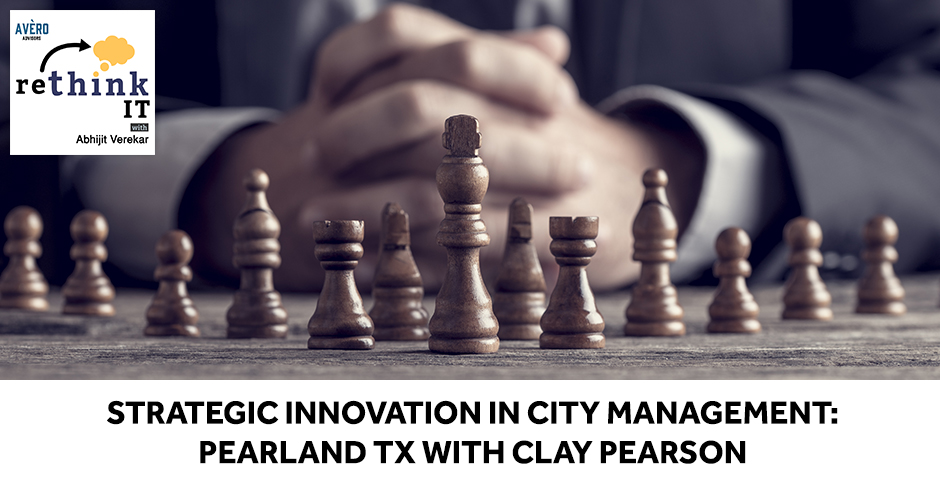Strategic Innovation In City Management: Pearland TX With Clay Pearson

The past two decades have been an era of hyper-growth for the City of Pearland, TX. For city manager, Clay Pearson, it’s just the right environment for his strategic and innovative mind to work. Having held the reins as Chief Executive Officer since 2014, he sees the need for the city government to be strategic and flexible in adopting information technology systems that allow it to keep up with the demands of ensuring quality life for a rapidly growing population. In this conversation with Abhijit Verekar, Clay shares the work they are doing for the city in terms of IT integration, his personal view of innovation, his definition of a smart city, cybersecurity concerns, IT in utilities and many more. Great things are coming for the city of Pearson and Clay is right at the helm of that journey.
—
Listen to the podcast here:
Strategic Innovation In City Management: Pearland TX With Clay Pearson
My guest is Clay Pearson from the City of Pearland, Texas. Welcome to the show.
Thank you. It’s good to be here. You’ve had some suspect people in the past that are friends of mine so we’ll see how this goes.
We’ve been talking for a little bit about you coming on the show and I appreciate you making the time. I know this is a difficult time in so many ways. Thank you for doing this. I’m always intrigued by the city manager job, and I’ve told my other city manager guests or friends how cool I think it is. Most city managers agree that it is a cool job. Tell me about your story and how you ended up as a city manager.
Likewise, I think it’s a fascinating job. We get the opportunity to run a public corporation, a conglomerate that does many things that people count on, see and don’t see. There’s the obvious of the police and fire service, the people in uniforms and the big trucks. We also provide the water and the wastewater systems that you count on that you and I both use. There are other things that we’re involved with in terms of quality of life and placemaking. I know that phrase is always used, but it is different and you get to work with great people.
You get to meet great people from all walks, economic development and long-term thinking. I enjoy all that. That’s why I like it. How did I get into this? I’ve been doing this for many years. I got a notice from the International City/County Management Association. That’s hard to believe. I’ve been very fortunate. I’ve worked in three cities, Elgin, Illinois outside of Chicago, Novi, Michigan outside of Detroit, and Pearland, right next to Houston. It’s been a great run. I feel very fortunate and we’ll keep on doing it as long as they’ll have me.
Part of the job is to strategize, be forward-thinking and come up with solutions to two different sets of problems that you face. The word innovative or innovation gets thrown around a lot in our line of work, what do you think innovation means as a city manager and you personally?
That word and all of that, frankly, it used to a lot and still does a little bit intimidates me. It’s like this expectation that you’re supposed to invent a new iPhone. In more calm moments, I realized that it’s what we’re about in terms of continuous improvement and continuous learning. I think I’ve done that. I always want something to be better. I know the people I get to work with. It’s frustrating because I’m always nudging and like, “What about this and that?” They’ve worked on something very hard and what else they can do is the last thing they want to hear. To me, a version of innovation and maybe there should be an innovation light or something.
People like me are less intimidated by it because you have to keep moving ahead and changing. I’ve always been a big change lover and the status quo doesn’t appeal to me very much and that pie fits with being in the city business because nothing is static. The world changes and impacts city expectations and the economy. We run a business and anybody thinks it’s old and staid, it isn’t paying attention, especially the state and the federal, I don’t think that they can be. That’s probably my bias because I don’t know their word, that’s dangerous, but it seems we’re able to adapt and we have to change. That’s why I like what I do versus some of those higher levels that sometimes make our life even more difficult.
Before we scheduled you to come to the show, you sent me some documentation on your projects that you have going on. Number one, you guys have a lot going on. I was thrilled that you guys are on top of it. You have a project list. You seem to have a strategy. Tell me about how that level of the organization comes about?
Nothing is static in the city business. Click To TweetI appreciate your expertise and you’ve seen different places. That means a lot when you notice that. When I got to Pearland, one of the things I asked for and changed was that the IT group come out of finance and report directly to me, we hired our first CIO. They had a good IT master plan, but that was a basis for some of the early planning. We brought in a great CIO and he’s built up a great team. We work that plan and that strategy that you saw because there’s so much going on here. Without that, you’ve got to have some priorities and we’ve brought in people to help us organize the work and give us those fresh eyes.
I’m a big Stephen Covey guy and that Q2 thinking. You’ve got to think about the work and strategize and not caught up in the grind of the day-to-day or the fire in front of you. We build up that project portfolio, which we meet on that monthly with my office, IT people and others. We share that broadly. Part of that is to let people know that they can’t do everything that you want the next day. Here’s why, here’s what else we’re working on and mark our progress. I believe in that system of systems and that systems thinking process and that’s the way we stay afloat because the City of Pearland has grown tremendously. We’ve gone from 30,000 people in 2000 to probably 140,000 people years later. We’ve added midsize American cities. The reality is that people move here and then you get to build up the infrastructure to service them after they’re here and that’s what we’re in the middle of.
It seems like the systems thinking that you’re adopting and pushing down to your organization, it sounds like it goes beyond IT. When you have that many people moving in at such a fast volume at such a fast rate, you have to pave the roads before you put the houses in and it seems like that’s what’s going on with your tech infrastructure too.
We have worked hard on getting master drainage plans. Drainage is an important topic around us. Water, wastewater, parks, pathways, sometimes easy and it’s glib to say, cities make these plans and that’s all we do. If you don’t do that, it’s chaotic and you’re not being strategic with your resources. People are even more likely to get burned out if they don’t have some sense that there’s a strategy. I’m not saying it’s an ironclad and it’s not flexible, but you’ve got to have some plan or a vision of all that. We’ve got the element plans. One thing we need to work on hard is an overall comprehensive plan for the city, get some of that higher-level thinking about where we want to be and what we want to be, but that’s probably the next iteration of all that.
You talked about having an IT strategy, that first spot you started with. What was that process like? We’ve been doing this for many years and back in the day, we were doing ten-year of IT strategic plans and not much changed. Meaning, we would do these plans and they would sit on someone’s shelf. Here we are in 2020 where things are changing at such a fast clip. What is your horizon for an effective IT strategy?
When I got here, the original plan, which was good, at least we had something. When I got here, we had BlackBerries and that was in 2014. I hadn’t seen one of those since my Elgin days many years ago, I said, “I can adapt. I can look at this.” That lasted all of 45 days. We changed the plan. There was also a commitment and there, which made some sense of not to be too product-specific, but Microsoft mobile platform. At that time especially, that didn’t seem where to go and we shifted to an Apple for mobile devices and we made a lot of investments with mobile. That’s passe now. To answer your question, I think if you have a six-month plan, that’s not bad. If you have a 2 or 3-year strategy, that’s great, but much more beyond that, it’s your wishful thinking.
We’re doing three-year plans with a stipulation that you look at it every year because you don’t want to be tied into it.
What I was thinking too is I’ll get some free consulting help from you, but maybe the idea is you’ve got to have some themes about mobile into our utility systems, which are very complex, large, getting into SCADA and into asset management. Those thematic things are probably more or as important for a strategy versus we’re going to buy X product and how are we going to get there.
The products changed. The same product will be sold to you with a different sticker next time. How does the jigsaw fit together? You brought up utilities. It’s such a critical aspect of city management. Those cities that don’t have utilities, I’d like to think that they don’t have as many moving parts. You’ve got a bunch of stuff going on, AMI and doing a redesign of your billing systems and processes. Yes, thematic thinking is what’s critical. The products these days are commoditized. They do the same thing. The differentiators are customer service and what kind of warranties you get on it, which isn’t strategic.

Pearland TX City Manager: Regionalization is both a strength and a weakness of the American government. It allows us to be small and responsive, but it makes it very hard to coordinate.
The other thing that we run up against is two things. The integration with other systems. That’s inevitable that that’s going to be required, and it’s also inevitable in my experience that it’s what they over promise and under deliver on that and fail. It’s horrible. Trying to make those integrations work and try to get at least a sense that the frontend that there’s a chance it’ll work. Seeing where the demos are incredibly important. The other thing would be the fact that these tech companies get bought and sold and who you’re dealing with is different and you buy something and then they phase out the product because the new companies don’t want to do that. It’s very frustrating.
We don’t resell anything. We see that a lot. Clients like you might hire us to say, “This vendor is trying to pull past over us. What do you think?” A lot of times, it’s exactly the same thing. I like to say that the vendors that will succeed with us or any client of ours are the ones that will not try to BS us and hold a certain level of customer service, no matter what they’re selling.
It doesn’t matter, whether it’s software or the hardware piece of it and those elements of integration and shelf life or something is important.
The thing that’s different in 2022 is that you’re not building anything from scratch. The wheel has been made, the Legos are in place. You need to find those pieces that fit your strategy. Many years ago, you probably had a larger IT department with coders and programmers building new stuff from scratch. We’ve moved away from that model to integrators that understand different pieces and can make outcomes happen for you.
It strikes me too just talking to you that the other thematic thing that has been constant has been the geospatial $2-word aspect is everything is based back. I’m a huge believer in GIS, but that’s the platform. When I started out at Johnson County, Kansas, I got an opportunity to work rotate, and they had me in the planning department and they had this thing called GIS. We had to write a paper explaining that and justifying the big expenditures. If I was smarter, I would buy in Esri and done that for the rest of my life. That’s been the constant and I’ve tried to support that internally here. That helps us a lot.
That’s critical on so many levels, utilities, public safety, permits, and zoning. We should be able to leverage as we have such a great product and almost everybody has it. I can’t think of one client of ours or anyone I know that doesn’t have Esri. The rub is when you have Esri but you don’t have the right talent to make use of such a great product. Sometimes you have the one guy that knows Esri in and out but doesn’t know the application side of it. They can make the database solid, but who’s using it? Nobody.
We were very fortunate. We’ve got our team with IT. Another thing we did was moved that together. That’s been good for us because it is the combination of database and then it’s integrating that and deployments. The people that we have, the leadership there and the talent there, they know the database and they know the applications like you said.
We had an unnamed client of ours, they hired Esri to come and do an assessment. Tell us how else we can use Esri? Sadly, the final report was nothing but a marketing document, “Here are all our products. Pick one.”
We had a couple of speakers come in like Dustin Heiser. He’s a smart guy. I liked doing that. We had somebody from Esri and they brought in a stack of playing cards that were their different applications. It was huge but it’s overwhelming too. It’s like, “What do we do with all this? It’s many ways.”
You have to think about the work and strategize, not just get caught up in the grind of the day to day. Click To TweetThe other trend is the regionalization of GIS because a map is a map. The county and the city use your parcel information. The county we lived in, Blount County, Tennessee has a regional GIS. The population isn’t as large as the Houston Metro, but we still have 150,000 to 200,000 people in 3 or 4 municipalities and they have one GIS agency. It’s not a perfect model, but I think it’s moving in the right direction.
One of the things is regionalization. The strength and weakness of the American government is fragmentation. We can be small and responsive, but it’s very hard to coordinate and you don’t get scale. The City of Pearland is in three different counties. We have to get appraisal data information, the base land information from three different counties to put in our GIS and they don’t have the same exact platforms and all that. They have different standards and different timeframes. It makes a hard job incredibly hard.
I know you’ve got an incredible CIO and an IT team. How do you personally stay on top of evolving tech?
That’s probably personal interest, passion and it layers in nicely with the need. Frankly, I’ll try to stay up and read a lot of business journals because that’s where you get the preview before it comes to the government side. You get applications that can come in whether it’s a customer service platform. It strikes me, we operate a pretty sophisticated call center, but we don’t call it that. We haven’t gotten into the 311, but maybe that’s down the road for us. Asking me that I would get to work with and I read a lot and share stuff and sprinkle around like, “What do you think of this?” It’s up to them to see what drives them or what they grab off. I look at the online platforms and the LinkedIn, that’s a great source for information, ideas and try to leverage that as much as possible.
When you have an idea as the city manager, as a strategic thinker, how do you translate that to your techies or do you have that CIO that as a translator?
That’s hard for a couple of reasons. I don’t have time or the bandwidth to follow up on every single one of these. That’s why that project portfolio is important to give a little bit of a structure from my perspective, to understand what all is being worked upon and where things stand. Some will pop up and say, “What’s going on with this? What’s the status of that?” That project portfolio and the structure of looking at that regularly precludes and designed to put less stress on the people doing the work. Me mapping in, “What’s going on with that? In the afternoon, what’s going on with something else?” As far as the ideas and all that, it’s a balancing act of what you think we can absorb. What are the resources?
I go back to that portfolio of trying to introduce it to that so that we can have a somewhat meaningful discussion about what’s realistic to get done with the resources we have. Even if you’re contracting it out, you have to manage that. It’s not a panacea. My last cubby thing is the idea of time. That’s our only limited resources. We’ve got the money to do what we want to do and what we think is important, but what can we spend our time upon? That’s what we have to value and think about the most.
That’s such an important thought because you can’t keep changing priorities. Once you’ve set something, the idea is one thing. I’m a PMP, it’s been beaten into me. Project plan, but you need to have that flexibility in it so you can pivot and bring new ideas to the table.
I’m going to get that PMP at some point. I value and appreciate the thinking and the structure of that, the processes at the beginning checking in. We’ve got a great engineering projects team, Robert Upton leads that group on our side. We’ve got a $500,000 worth of capital improvements in our portfolio. Over time, we’ve perfected that. One of my favorite reports is their bi-monthly milestone report. It’s very simple. Two pages for that $500,000, but at least it gives me a sense of the regimen of the design, the land acquisition, construction, bidding, etc. That’s a great dashboard. I know that gets thrown around and overused a lot, but that’s another area of that.

Pearland TX City Manager: Time is a limited resource. You can have the money to do what you need to do, but you have to think about what you can spend your time on.
It does get thrown around a lot in. I don’t think there are many useful functional dashboards around for how easily people say the word dashboard and how many tools there are. It all comes down to what you mentioned is, “What do you want to see?” My personal philosophy is vision drives, business process drives the tools and technologies. If you haven’t done the first two pieces right, no matter how good your dashboarding tool is, it’s not going to give you what you need.
We had helped to design that IT dashboard, that project portfolio. We’ve got a good one for the projects. Another area that we’re working on and I’m confident they’ll get it because they’ve got good people there. They’re in public works because they’ve got a bazillion indicators of activities and we’ve got to take the next step to get that into what’s important for my level, their level. They are different things probably. Project manager and engineering, the milestone report that I’ve got don’t do them any good for the hundreds of things they have to manage underneath that. I realized that.
You don’t want to be in those weeds. It might be your interest, but it’s not that you’re being held accountable for.
That’s the other piece of it. You asked about how do I structure the priorities. Anybody that I get to work with is probably laughing and shaking their head. I dive in and get some of the details, ask them a lot of questions, going curious and want to learn and be interested, but then I’ll move on to something else. I realize that can be frustrating, but over time, I think we all get an appreciation for each other and they get the rhythm and there’s less of that. That’s the advantage of working with a team over years and getting things done here.
New ideas are always stimulating to me. The other thing I wonder about is what you mentioned, words that get thrown around. Smart city is the latest and greatest. It can mean many different things. What does it mean to you?
That’s very appealing to me as a concept and it has been. I remember when IBM was running that and spent billions of dollars on advertising marketing about smart cities. That was appealing to me because it added technology to the systems, speed, efficiency, real-time information, but I don’t know where they’re at with it. Now, it’s more of a generic term and we’re building that. I think our smart city is the system of systems of remote sensing. We’ve got traffic cameras. We’re going to have SCADA. We’re going to have drainage markers.
There’s a great system for the drainage channels that’s available that we use, and then integrating those, compiling those and using those. Asking good questions, indicators, one of our people got one of the dashboards from a department and said, “This is nice, but where is the good on here?” What’s the red line, green line, yellow line? We are adding that information layer that on there so you don’t have to interpolate it too much. I’m all over the place, as you would expect. That smart city to me is building up the system of systems with those and integrating the sensing, the information and the action.
This is great because you articulated it. It’s not so much the sensors, it’s what you do with it. Before you do it, think about what outcomes you want. Many cities and counties are smart already, they don’t label themselves as such. SCADA has been around for some time and it tells you when things are about to overflow.
For the next generation, the AI piece and I’ve seen some demos and advertising. A sensor on a pump that notices when it’s starting to grind a little bit less, imperceptible maybe. It gives you alerts that, “In two weeks, this thing is going to fail,” and learn from that. To me, that’s another generation, but trying to understand and manage that. Even if you get the alert, we’ve had that happen in some of our stations. It doesn’t matter if there’s an alert and it’s got an alarm. If it’s not telling somebody, if somebody is not picking up that call or reacting to that and going out to the site before it overflows, it doesn’t matter.
Take care of the work and prepare for the next wave. That is what innovation means. Click To TweetThis one is not so much a buzzword as its reality, but cybersecurity and ransomware. How much do you worry about your organization in general and the industry?
It’s a big concern and it’s one of those things that you probably don’t worry about enough until you have a big problem. We get the attacks, but there hasn’t been anything sustained or ransom on a large scale. We’re trying to be proactive. It’s like emergency management. You need to build the redundancy, recovery and alerts to systems like anything. We’ve got a great person within IT who’s been trained up and all that, but frankly, he’s being pulled in so many directions with that portfolio. He’s got some huge priorities that when we meet and we talk about the cybersecurity elements within that. Fortunately, even though it’s so important, we haven’t been able to dedicate as much as we should and like. We’ll get there. We’re still in good shape. It’s layers, it’s always changing and who knows what’s going to happen next.
I would say that there are some great tools out there, but with anything else, the process around it and education is critical.
There were some attacks in other places in Texas. The state legislature passed this law without much structure and without any funding that said, “Everybody is going to take cybersecurity awareness training.” We followed that. I wonder how many people around this big state have done that, but I question the value of that particular effort at that level versus some other opportunities and needs.
In Texas, interestingly, the state has a task force. If you get hit, you call the cybersecurity 911 and they show up.
I haven’t heard of that. You’re ahead of me. I wouldn’t want to put all my eggs in that basket. It’s a reality.
You’re right in the standardized education. You need people to be aware of what things are but at the end of the day, don’t click on that email that you think is suspicious and download something.
One of the instances we had was a vendor came in and attached their device into our system and that caused all kinds of problems. I don’t think it was an attack per se. We didn’t open the door but something got introduced and it created chaos for two days and we were crippled. Those are frustrating and not good for anybody. I don’t think that classifies as cybersecurity, but the system resiliency and redundancy is so important.
It does because it chips away at one layer of your fortress. What is the biggest challenging project you have going on not just technology?

Pearland TX City Manager: Being a smart city entails building up a system of systems and integrating information and action.
It would be a technology base and that’s our conversion to an advanced metering infrastructure. The meters themselves have been largely installed. That was a hard slog, but we’re touching 35,000 to 40,000 front yards for the meter conversions and swap outs. To fully realize that, we’ve got to get a network, a mesh of towers installed, and connect grid routers on those towers to read those meters. That’s been a challenge and right now, we get to read it old school, which is okay, but we’re not getting the full potential of that. We’ll get there. It’s the scale of that has been a problem. We’ve had other issues behind that and associated with it that have compounded it. We’ll get through that by the end of 2020. I’m very hopeful but it’s stressful to get to that point.
Is it just water and sewer?
Yeah. Air conditioning is probably about as important as water on here. Electric utilities had those systems. I get alerts and bills, but we’ll get there. It just takes time.
Clay, it’s been a pleasure having you. Is there anything else you want to say to our readers?
I enjoy talking and your material. I look forward to following that closely. I hope this helps a little bit. We’re in a good space and we’re doing some things very professionally. We had a meeting with some of the smart people at Rice University. We talked about data to knowledge and we got some good things. The combination is taking care of the work and then preparing for the next wave. Some of the stuff with Rice is doing that and into Microsoft BI. I don’t know how to use it, but I love what it’s doing. We’ve got some great people in finance. Maybe the combination of that with our GIS and we could have a great thing here not too distant future. You’ll be kind enough to let me come back in a year or even better talk to somebody that’s doing the work and hear what has happened.
I would love to see how this looks in 2021. You’ve got the pieces and the hard parts down with the right organization and process thinking. It’s been great talking to you, Clay.
Thank you. I appreciate it.
Important Links:
About Clay Pearson

Clay has diversified world-class experiences in professional local government management, finance, public safety, economic development, technology, operations, and strategic planning. He also serves as Chief Executive Officer for the City of Pearland, Texas.
Added depth with exposure and professional development to South Africa, Japan, New Zealand, India, China and through Europe. Experienced providing summer 18-hour undergraduate teaching in US Local Government to China University of Political Science and Law.
